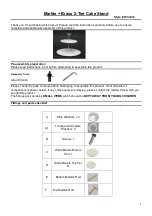
8
18. TRANSPORT
Because of their inherent stored energy and flammability, Lithium-ion batteries
are considered “Dangerous Goods” and must be transported in accordance
with all regulations. The classification for the battery is Class 9 according to the
Recommendations on the Transport of Dangerous Goods, Manual of Tests, and Criteria.
Anyone shipping batteries must be trained as required by local regulations in order to
ship hazardous goods. Air shipment requires competent authority approval according to
local jurisdiction’s department of transportation.
UN “Recommendations on the Transport of Dangerous Goods, Manual of Tests and
Criteria”, chapter 38.3 (known as UN38.3) has been applied and product tested to UN
38.3 with test summaries available upon request.
Damaged batteries must be transported based on all applicable regulations for
damaged Lithium-ion batteries. These requirements are in addition to the standard UN
38.3 criteria. Contact EnerSys
®
for assessment and support in transporting damaged
batteries.
For further transport and regulatory information (USA and EU; classifications and
labeling) refer to Lithium-ion Battery (Module) SDS:829515 instructions or regulations by
the International Civil Aviation Organization (ICAO), International Air Transport Association
(IATA), International Maritime Dangerous Goods (IMDG), Convention concerning the
Carriage of Good by Rail (CIM), and Annex A: International Regulations concerning
the Carriage of Dangerous Good by Rail (RID) codes. Other laws and regulatory
requirements may apply depending upon a given location. It is required for all persons
shipping to become familiar with the applicable regulations.
19. STORAGE
The battery must be best stored in a dry environment away from fire, sparks, and heat.
The allowable storage temperatures are -40°F (-40°C) to 140°F (60°C).
Storage area must be compliant with local fire, safety and building regulations for
Lithium-ion batteries and in accordance with the building’s insurance.
Battery must only be stored in upright position (comparable to the installation in the
vehicle) with all service lids properly attached.
During storage, it is not necessary to disconnect the power connection between the
industrial truck and battery however it is highly recommended to disconnect the truck
and battery communication connector.
For storage of greater than one month precautions must be taken to ensure the battery
is not deeply discharged. The pack must be stored at 30%-70% SOC. In addition,
processes and recharge methodology must be in place to ensure that battery does not
discharge to 5% SOC in storage. It is recommended to turn the pack on and check the
SOC every six months and recharge to greater than 30% SOC if the SOC has dropped
below 30% SOC. Maximum temperature of long term storage location should be less
than 35°C.
20. SERVICE AND MAINTENANCE
The battery has been designed to be maintenance-free. However, external cabling,
connectors, etc. (including operator interfaces) must be examined periodically as
required to ensure there is no damage to such parts. If any of these parts are damaged
or show signs of serious wear, they need to be replaced. Please contact your local
EnerSys service center for all repairs and replacements. All repairs must be done by an
EnerSys technician trained on Lithium-ion products.
All power cables must be checked every time the battery has been exposed to any type
of stress, whether it be overvoltage, overcurrent, or any mechanical stresses such as
crushing.
21. DISMANTLING
Dismantling of the battery is not authorized except by qualified EnerSys personnel
due to the numerous hazards involved with dismantling a battery
(e.g. recycling, service).
22. DISPOSAL AND RECYCLING
NOTE: Disposal must be in accordance with local regulations. Do not dismantle,
incinerate, or crush battery systems.
In case of irreparable failure or end of life, the battery must be taken out of operation in
a controlled manner. The battery should not be dismantled by the customer. Specialized
handling and recycling are required for damaged products. Do not dispose of waste
batteries as unsorted municipal waste.
EnerSys, in line with Local regulations, will accept NexSys iON products at specific
facilities for disposal. Contact your local EnerSys representative for specific recycling
instructions per region.
23. TROUBLESHOOTING
If the battery is inoperative, please be sure that the battery traction connector is either
connected to the vehicle, or in a safe state as to not short,
No Power to the Truck
Check the following items:
1. No active errors
2. No active errors are listed by the display. If “Lockout” is displayed call Service
3. Ensure the battery is turned on (operator interface(s))
4. Power cycle the battery
5. Ensure charger is not plugged in as power to the truck is turned off during charging
in order to prevent drive away from the charger
6. Inspect power cables to truck to ensure there is no damage
7. Review error ID checklist below
Battery Will Not Charge
Check the following items:
1. Ensure charger is powered and charger indicates, “Connect Battery”
2. No active errors listed by the display. If “Lockout” is displayed, call Service
3. Power cycle the battery
4. Ensure charge cables are properly connected to charger
5. Ensure battery is connected to an EnerSys
®
Lithium-ion enabled charger
6. Connectors, auxiliary pins and CAN wires for damage
19. STORAGE (CONTINUED)
17. TECHNICAL PARAMETERS (CONTINUED)
Содержание NexSys iON 24-L1-20-4.7
Страница 1: ...Owner s Manual www enersys com ADVANCED LITHIUM ION TECHNOLOGY Li ion TECHNOLOGY ...
Страница 11: ...11 ...






























